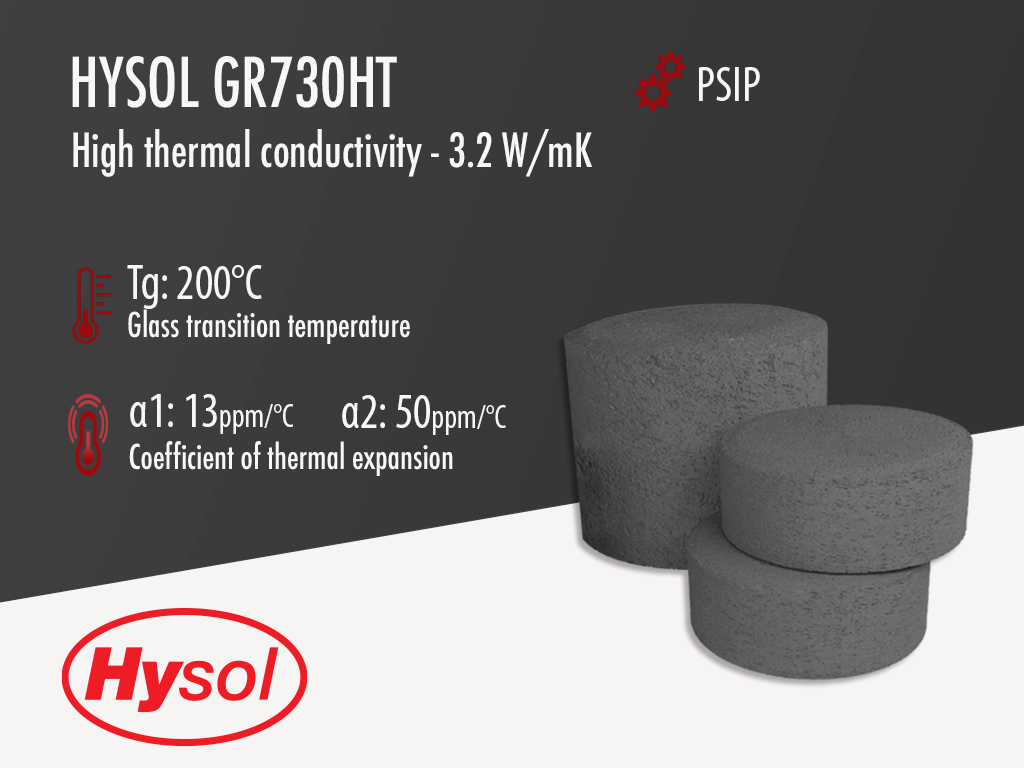Hysol GR730HT| Black Epoxy Mold Compound
Harmonization Code : 3907.30.00.40 | Epoxy Mold Compounds containing by weight more than 70 % silicon dioxide
Main features
- Halogen free
- High adhesion
- High thermal conductivity
Product Description
Hysol GR730HT is a halogen free, black, silica filled (90% filler weight) semiconductor grade epoxy molding compound designed for Power Supply in Package (PSIP). This low stress, low moisture absorption product is a commercial success with many uses on TO applications.
Hysol GR730HT is a black, heat curable epoxy molding compound that can be used in semiconductor packages such as TO252. Furthermore, it meets UL 94 V-0 flammability at 1/8 inch thickness.
Technical Specifications
| General Properties | |
| Color Color The color | Black |
| Filler Content | 90 % |
| Specific Gravity Specific Gravity Specific gravity (SG) is the ratio of the density of a substance to the density of a reference substance; equivalently, it is the ratio of the mass of a substance to the mass of a reference substance for the same given volume. For liquids, the reference substance is almost always water (1), while for gases, it is air (1.18) at room temperature. Specific gravity is unitless. | 2.84 |
| Electrical Properties | |
| Volume Resistivity Volume Resistivity Volume resistivity, also called volume resistance, bulk resistance or bulk resistivity is a thickness dependent measurement of the resistivity of a material perpendicular to the plane of the surface. | 8.0x1015 Ohms⋅cm |
| Chemical Properties | |
| Moisture absorption | 0.24 % |
| Thermal Properties | |
| Glass Transition Temperature (Tg) Glass Transition Temperature (Tg) The glass transition temperature for organic adhesives is a temperature region where the polymers change from glassy and brittle to soft and rubbery. Increasing the temperature further continues the softening process as the viscosity drops too. Temperatures between the glass transition temperature and below the decomposition point of the adhesive are the best region for bonding. The glass-transition temperature Tg of a material characterizes the range of temperatures over which this glass transition occurs. | 200 °C |
| Thermal Conductivity Thermal Conductivity Thermal conductivity describes the ability of a material to conduct heat. It is required by power packages in order to dissipate heat and maintain stable electrical performance. Thermal conductivity units are [W/(m K)] in the SI system and [Btu/(hr ft °F)] in the Imperial system. | 3.2 W/m.K |
| Physical Properties | |
| Spiral Flow @ 175°C | 76 cm |
Additional Information
| Property | GR730HT (86W9HT) | GR730HT (96G18) | XX-G1250S X5HT | XX-G3000HT |
| Filler content | 90 | 90 | 86 | 87 |
| Epoxy | Modified Multi functional type | Hydrophobic EP | Modified Multi functional type | Hydrophobic EP |
| Spiral Flow (inch) | 76 | 86 | 120 | 120 |
| Gel time (s) | 20 | 30 | 30 | 35 |
| Viscosity (PaS) | 12 | 10 | 15 | 8 |
| Specific Gravity | 2.84 | 2.67 | 2.93 | 2.85 |
| CTE 1 | 13 | 13 | 14 | 15 |
| CTE 2 | 50 | 40 | 48 | 50 |
| Tg (°C) | 200 | 122 | 215 | 130 |
| Flexural Strength/Modulus, Mpa | 104/ 23000 | 122/ 24000 | 143/ 29000 | 180/ 25000 |
| Mold Shrinkage (%) | 0.14 | 0.25 | 0.12 | 0.33 |
| Moisture Absorption PCT | 0.24 | 0.24 | 0.45 | 0.35 |
| Volume Resistance (@ 150) | NA | NA | 5E12 | 5E12 |
| Volume Resistance (@ RT) | 8E15 | 7E15 | NA | NA |
| Impurity CI- | 9 | 9 | 9 | 8 |
| Thermal conductivity (W/mK) | 3.2 | 3 | 2.9 | 3 |



